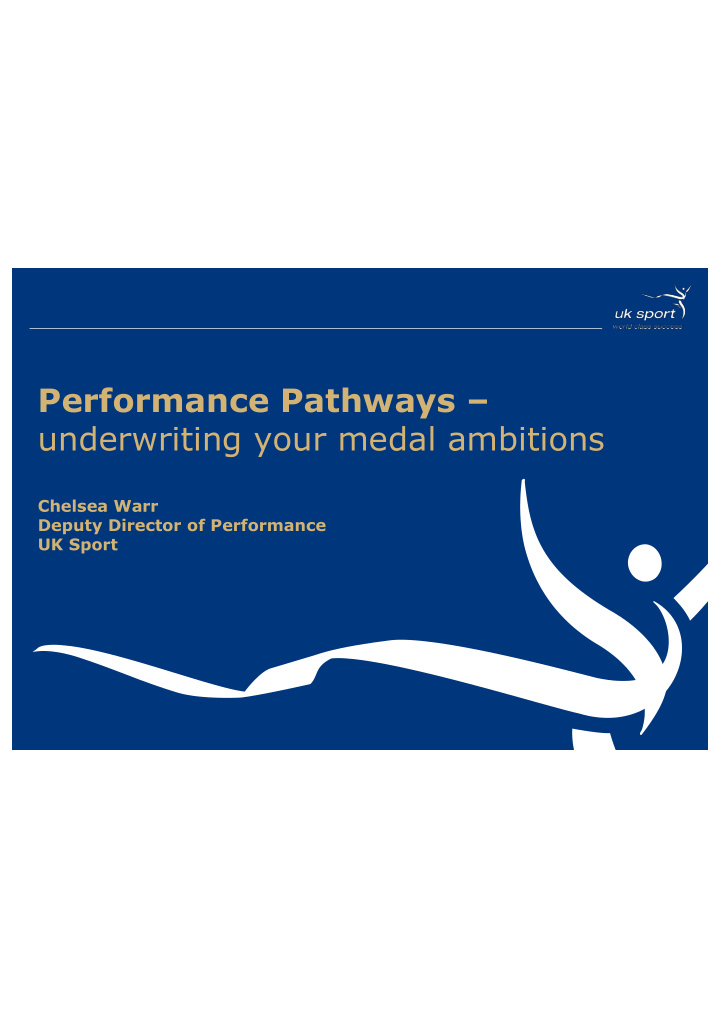



Performance Pathways – underwriting your medal ambitions Chelsea Warr Deputy Director of Performance UK Sport
I am an architect of days that haven't happened yet John Mayer
What are three areas you feel, as a National system, need to be addressed to enhance performance pathways? 12 10 8 6 4 2 0 Alignment APS Coaching Education Expertise Fundamentals Investment Leadership
2024 2020 2016 2012
If ¡you ¡didn’t ¡have ¡a ¡Pathway…what’s ¡to ¡ say ¡you ¡won’t ¡make it anyway?
A Performance Pathway 2016 Years From Podium 2020 2024
Building a Performance Pathway DESIGN & ALIGN 2. Supply 4. 6. 5. 1. WITTW 3. Recruit & Confirm Measure Develop Demand Talent Management
Step ¡1: ¡‘WITTW’ ¡– start with the end in mind • What will medal winning performances look like in 2024 & 2028? • What do performance trajectories and precedent analysis tell us? • Do we really know the discriminating factors to winning? • What do the brutal facts tell us?
Step 2: Supply, Demand • What do our flow rates tell us? • What are our depth charts signalling? • Where are our gaps & oversupplies? • How many do we need, to what standard & by when?
Step 3: Attract & Recruit • How easy is it to access the pathway? • How do you get noticed? • Are we measuring performance or potential? • Where are the consistent Talent hotbeds? • Are you using a selection of TID/Selection and Talent Transfer?
2007
2008
2008 8
2009
2011
Helen Glover – Sporting Giants
Lizzy Yarnold – Girls4Gold
Karen Darke – Paralympic Potential
Lutalo Muhammad – Fighting Chance
Step 4: Confirmation “It’s ¡not ¡the ¡strongest ¡of ¡the ¡species ¡that ¡survives, ¡nor ¡ the most intelligent, but the ones most responsive to the ¡environment” ¡ ¡ [Charles Darwin] • How sure are we? • Are they a responder or non responder? • What questions are left unanswered about this athlete? What experiences do we need to create to answer them confidently?
Confirming ¡cont… ¡ These are not super humans with rare super genes. They are participants in a culture of the extreme , willing to devote more, to ache more, and to risk more in order to do better [David Shanks]
Step 5: Development We went looking for exceptional musicians. All we could find were exceptional environments.
Sport
Military
Military
Step 5: Development • Do we have a clear curriculum? • Are the training plans focussed on the long-term development of the athletes, ¡or ¡‘tomorrows ¡performance’? • Are we over competing and undertraining? • How much is mistake making encouraged? • Do we facilitate a high challenge, high support environment that incentivises progression? • What support services make the difference for an emerging athlete? We went looking for exceptional musicians. All we could find were exceptional environments
If you want to be an elite athlete, you need to choose your parents very carefully
Step 6. Measurement
Building a Performance Pathway DESIGN & ALIGN 2. Supply 4. 6. 5. 1. WITTW 3. Recruit & Confirm Measure Develop Demand Talent Management
Foresight from Hindsight GREAT BRITISH MEDALLISTS – Developmental Biographies of High Achieving Athletes
Groups Super-Elite • Funded WCP GB Athletes 0y Study Won a gold medal at a World • Championships or Olympics Cohort Podium plus at least one other medal at a World • 2y Championships or Olympics Superior reproducible performance • 4y Years From Podium Potential Podium Elite 6y • Funded WCP GB athletes Won at least one medal at a significant • international competition (SNR or U23) 8y such as a World Cup or European Championships, Performance Foundations Had not won a gold medal at a World • Championships or Olympic Games. 10y
Areas Studied • Demographics • Positive and Negative Critical Events • Early Childhood Experiences • Motivation, Commitment and Desire to compete • Practice, Training, Competition • Pressure Zone and Emotional Regulation • Competition Milestones • Personality • Pathway Experiences • Context and WCP Environment • Relationships with Family Coaches
Some Summary Findings • Super elite athletes were born earlier in the year and in smaller towns than elite athletes • Super elite athletes completed a larger volume of overall activity per year encompassing, practice and play in their main sport, practice and play in other sports and general physical activity • Early sporting success was not predictive of senior medal success • Super elite athletes specialised later than elite athletes and showed a trend towards a greater volume of play in other sports during development • Coaches met the needs of Super-Elite athletes better than they did Elite athletes • Super-elite operated outside their comfort zone and study themselves failing • Super-elite craved and thrived on immediate and constant feed back • Super-elite athletes experienced childhood trauma
Coconuts FANATICALLY TALENTED ATHLETES PURSUE THE MUNDANE & PRACTICE A LOT PERSONALISED AND INDIVIDUALISED COACHING NO LIMITS ENVIRONMENT ELIMINATE INJURY & SICKNESS OPPORTUNITIES, CHOICES, NO GUARANTEES ALIGNED & SUSTAINED INVESTMENT SUSTAINED SUCCESS
25 minutes Task 1 Groups of 8 - 10 As ¡a ¡group ¡define ¡what ¡‘talent’ ¡is? ¡ (group consensus) Define the top 5 elements that you feel most ¡accelerate ¡an ¡athlete’s ¡progression ¡ towards future Podium Performance?
Task 2 25 minutes Groups of 8 - 10 How do you know its working ?
Task 3 – Building a Performance Pathway DESIGN & ALIGN 2. Supply 4. 6. 5. 1. WITTW 3. Recruit & Confirm Measure Develop Demand Talent Management With the person beside you, take time to reflect and answer these 2 questions: 1. Reflecting on your sports, what area you at now? Where are your super strengths & where are you vulnerable? 2. Where is there a noticeable difference in sports with a track record of sustained success?
- END -
Recommend
More recommend